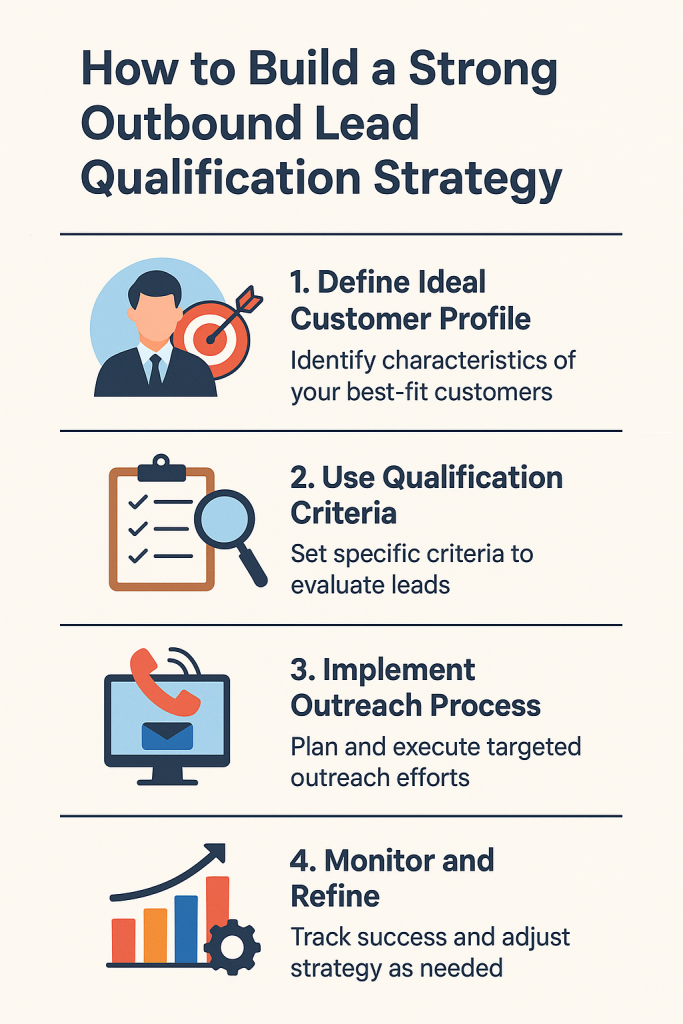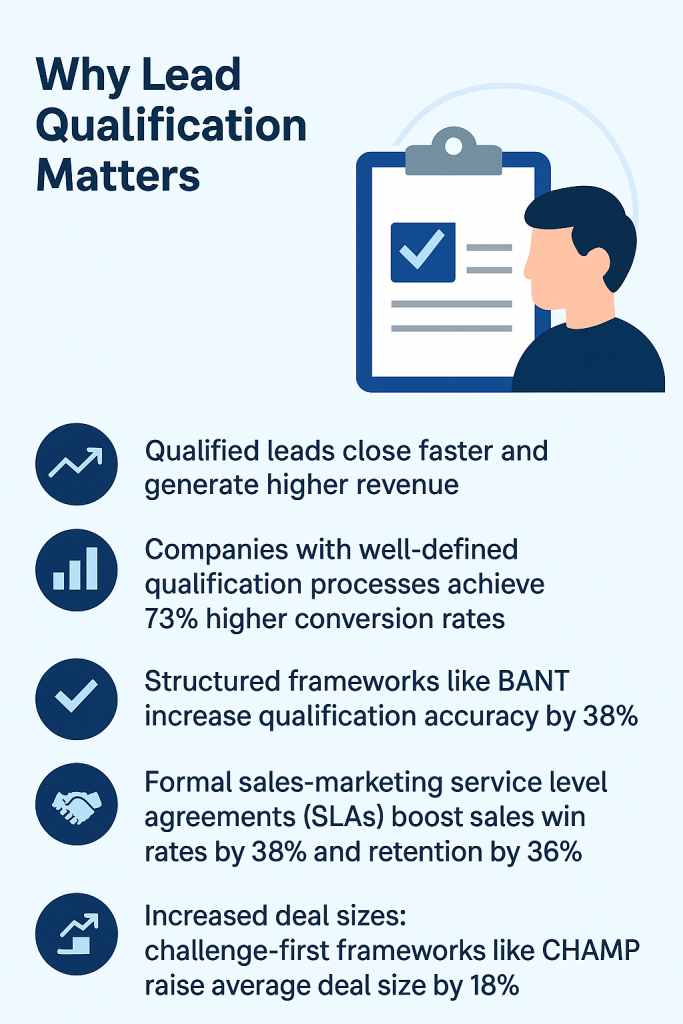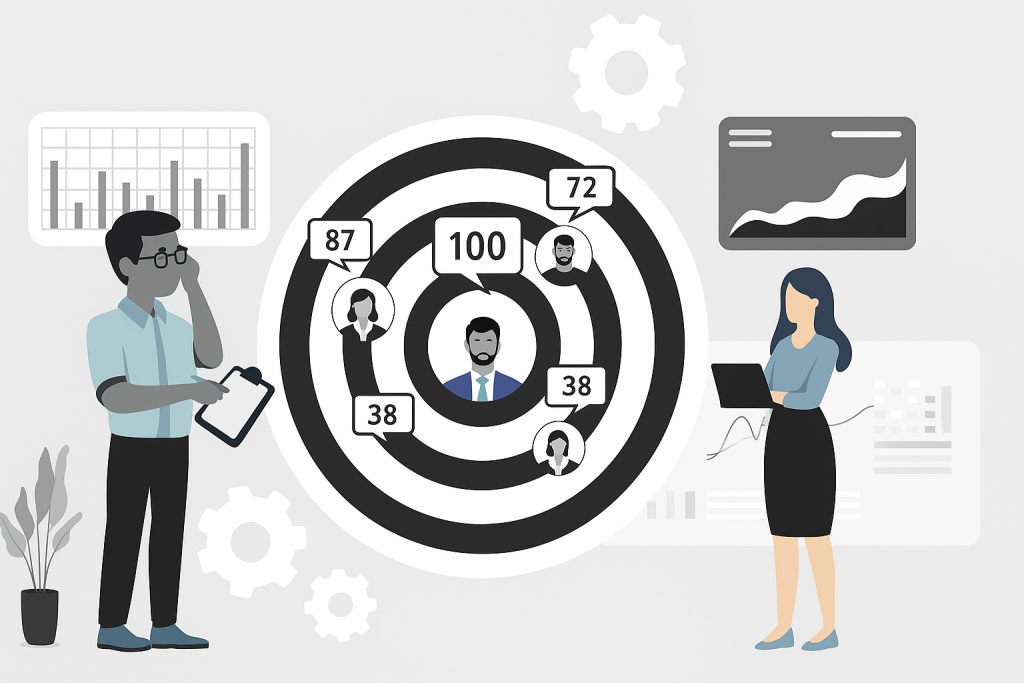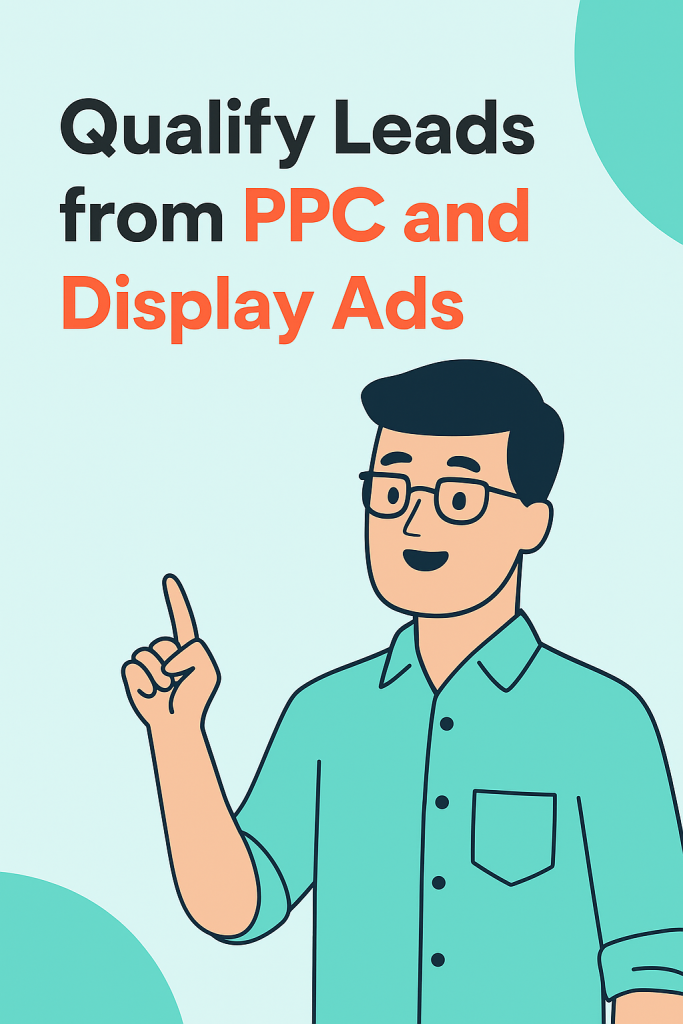Poorly qualified leads waste time and money. A report in 2025 found that only 25 % of marketing‑generated leads are ready for sales. Several firms fail to even qualify criteria consistently, only 39% could do so.
Unqualified prospects clog pipelines, sales reps become overwhelmed, and deals stall. Lead generation itself is expensive: organizations spend $198.44 per lead on average, there are various tools like the Ads Optimizer that can help lower costs by refining campaigns and attracting higher-quality leads.
Meanwhile, cold calls hardly work; 97 % of people ignore them. Services that include AI Chatbots qualify leads in real time and prevent sales teams from wasting effort on weak customers, this is where these AI tools leverage visitor data to offer tailored product suggestions, improving conversion rates by showing customers products.
This guide explains how to build an effective outbound lead qualification plan. It draws on recent studies and proven frameworks. All sentences use simple words and short lengths (8–18 words) to ensure a readability score above 90.
Below are some of the steps that can help you identify the right customers, where you can understand how to engage with them quickly and align your marketing and sales strategies.

Qualified leads close faster and generate higher revenue. Companies with well‑defined qualification processes achieve 73 % higher conversion rates. Structured frameworks like BANT increase qualification accuracy by 38 %.
Formal sales‑marketing service level agreements (SLAs) boost sales win rates by 38 % and retention by 36 %. Without qualification, teams chase the wrong prospects. Research shows that only 5 % of salespeople consider the leads they receive to be very high quality.
Response time is another critical factor. Harvard Business Review research suggests a 10 × drop in qualification success when response times exceed 5 minutes. Responding within one minute increases conversions by 391 %.
Waiting even 10 minutes reduces conversion by 400 %. Slow responses not only harm conversions; they push prospects to competitors, about 30 % will choose a competitor if you don’t respond quickly. These numbers show that speed and structure together drive success.

44 % of sales reps are too busy to follow up with leads.
45 % of B2B firms say generating enough leads is their biggest challenge.
55 % of leads are neglected when firms lack qualification criteria.
Increased deal sizes: challenge‑first frameworks like CHAMP raise average deal size by 18 %.
An Ideal Customer Profile (ICP) describes the companies and roles that will benefit most from your product. SiriusDecisions reports that organizations with detailed ICPs have 68 % higher account win rates. A clear ICP guides your outreach and helps you spot good fits quickly.
When crafting an ICP:
Firmographic factors: industry, company size, revenue, and geographic location.
Technographic details: current tools, technology stack, and integration needs.
Pain points: key challenges that your product solves.
Decision makers: titles and roles involved in buying decisions.
Review your ICP regularly. The best companies adjust their profiles every quarter based on feedback from sales and customer success teams. This ensures you target accounts that match your evolving offering.
Quality outbound leads begin with smart prospecting. B2B buyers do most of their research before talking with sales. Studies show that 57 %–70 % of the buying process happens before contact. On average, seven people participate in B2B buying decisions, and 90 % of buyers review two to seven websites before choosing.
Tips for research and prospecting:
Leverage intent data: Companies using buyer intent signals convert 73 % more MQLs to SQLs. Monitor websites, review sites and industry publications to identify active buyers.
Enrich data: Use professional databases and tools to verify emails, roles and company details. Accurate data reduces misfires.
Personalize outreach: Reference relevant pain points or industry trends in your message. Avoid generic pitches; they feel like spam.
Use social channels: Social media influences B2B purchases; 85 % of CEOs and VPs use social platforms to make decisions.
Offer value first: Share articles, guides or benchmarks relevant to the prospect’s role. SEO Tools can amplify this step by boosting organic visibility, ensuring your content reaches decision-makers earlier in their research process.
Frameworks provide a repeatable structure for qualifying leads. Select the framework that fits your business model and sales cycle.
The BANT framework stands for Budget, Authority, Need, and Timing. TechTarget explains that BANT evaluates whether a prospect has a budget for your solution, authority to make the purchase, a genuine need, and an appropriate timeline. Because of its simplicity, BANT is widely used. A Harvard Business Review study found that structured frameworks like BANT increase qualification accuracy by 38 %.
When to use BANT:
Best for small to mid‑market deals where budget and authority are clear.
Works well when you need a quick yes/no assessment.
Use it as a starting point and refine criteria as you learn more.
MEDDIC is the short form of Metrics, Economic buyer, Decision criteria, Decision process, Identify pain, and Champion. The idea behind this was to solve complex B2B sales. MEDDIC focuses on quantifying success metrics and mapping decision makers. Gartner’s research shows that companies using MEDDIC report up to 40 % higher win rates.
Use MEDDIC when:
You sell to large enterprises with multiple stakeholders.
Your product requires quantifiable ROI to justify purchase.
Longer sales cycles demand deep discovery and multiple touchpoints.
The CHAMP framework (Challenges, Authority, Money, Prioritization) begins with the prospect’s challenges rather than budget. By focusing on pain points first, CHAMP aligns with consultative selling. Forrester found that companies using challenge‑first qualification methods achieve 18 % higher deal sizes.
Choose CHAMP for:
Professional services or consulting, where understanding client pain is critical.
Situations where prospects may not realize the full cost of inaction.
Deals where budget discussions follow naturally after needing exploration.
GPCTBA/C&I is a comprehensive framework developed by HubSpot. It stands for Goals, Plans, Challenges, Timeline, Budget, Authority, Negative Consequences, and Positive Implications. This approach explores both goals and challenges, creating a holistic picture. LinkedIn’s State of Sales report shows that organizations using advanced frameworks like GPCTBA/C&I achieve 35 % higher quota attainment.
Use GPCTBA/C&I when:
Your solution has a significant organizational impact.
You need to understand both the positive outcomes and consequences of not buying.
You want a structured yet flexible framework that adapts to varied prospects.

While frameworks guide conversations, the main agenda of lead scoring is to add numbers to the process. Lead scoring assigns points to explicit and implicit attributes, such as job title, company sizes, or email engagement.
AI tools that have featured AI Tools which can calculate the long-term value each customer brings can enhance scoring by predicting which leads bring the highest long-term value.Businesses that are using lead scoring experience 15–20 % higher conversion rates and cut sales cycles by 30 %.
Only 44 % of companies currently use lead scoring. Implementing a scoring model helps your team focus on the most promising prospects.
Steps to build a scoring model:
Define your criteria: Combining your firmographic data like industry and revenue, demographic data (role, seniority), and behavioral signals (downloads, page views, event attendance).
Assign weights: Higher points for attributes closely tied to closed deals. Adjust weights based on historical data.
Set thresholds: Determine the score that qualifies a lead as sales‑qualified. Leads below the threshold stay in marketing nurture.
Align with sales: Create shared definitions of Marketing Qualified Lead (MQL), Sales Accepted Lead (SAL), and Sales Qualified Lead (SQL). Organizations with formal SLAs between marketing and sales see 38 % higher win rates.
Refine regularly: Review conversion patterns and adjust scoring every quarter. Use intent data to refine weights; companies using intent signals convert 73 % more MQLs to SQLs.
Speed is critical. The speed‑to‑lead principle means responding quickly improves conversion. Chili Piper’s analysis of 4 million form submissions found that responding within one minute increases conversions by 391 %. Wait more than five minutes, and qualification success drops tenfold. After 30 days, 90 % of leads go inactive. To avoid losing prospects to competitors, build a process for fast follow‑up.
Best practices for outreach:
Automate responses: Use tools to send instant confirmation emails or SMS messages. Include a scheduling link.
Offer form scheduling: Allow prospects to book a meeting right after submitting a form. This doubles conversion rates from 30 % to 66.7 %.
Provide live call options: Giving prospects an option to connect by phone raises conversion to 69.2 %.
Eliminate double forms: Companies that remove redundant forms see a 50 % increase in conversion.
Ask qualifying questions up front: Use forms to gather key information (company size, role, challenge). Chili Piper’s data shows that 14.1 % of people filling out forms are not qualified. Filter out spam and non‑prospects early.
Use multiple channels: Email remains effective, but social media and phone calls have their place. About 80 % of sales require more than five follow‑ups, so persistence matters.
During calls or emails, keep qualification conversations structured. Ask about budget, authority, need, timeline, current challenges, and decision process. Use open‑ended questions to uncover pain points. Keep messages concise; each interaction should provide value and move the conversation forward.
Misalignment between marketing and sales wastes leads. A report shows 54 % of sales leaders say alignment with marketing boosts revenue growth, and 61 % of marketers say content created with sales generates higher‑quality leads. Yet only 39 % of firms consistently apply lead qualification criteria.
How to align teams:
Create shared definitions: Agree on what constitutes an MQL, SAL and SQL. Use scoring thresholds to formalize these stages.
Apply SEO Tools: Boost organic reach and ensure inbound leads are better aligned with sales needs.
Set response time goals: Define how quickly sales must follow up on leads. Use dashboards to track compliance.
Establish SLAs: Document responsibilities and timelines. Organizations with formal SLAs see 38 % higher win rates.
Encourage feedback loops: Sales should provide feedback on lead quality. Marketing can refine targeting and messaging based on this data.
Share content: Provide sales with case studies, comparison guides and industry research. Content is crucial, 70 % of buyers prefer to learn through content.
Use Ads Optimizer: Improve campaign targeting so marketing delivers higher-quality leads to sales.
Track metrics to assess your outbound qualification strategy and make improvements:
Metric | Description | Benchmark or Insight |
Cost per lead | Average cost to acquire a lead. | Average across industries: $198.44. |
Response time | Time from lead creation to first contact. | Respond within 1 minute for 391 % higher conversions; avoid exceeding 5 minutes. |
Form fill qualification rate | Percentage of form submissions that meet qualification criteria. | Chili Piper found 14.1 % of form fills are unqualified. |
Qualified booked meeting rate | Percentage of qualified leads that schedule a meeting. | Form scheduling raises rate from 30 % to 66.7 %; live calling increases to 69.2 %. |
MQL‑to‑SQL conversion rate | Percentage of MQLs that become SQLs. | Varies by industry; B2B SaaS averages 13 % while e‑commerce can reach 23 %. |
Win rate | Percentage of SQLs that close. | Increases by 40 % when using MEDDIC. |
High‑performing sales teams are 2.3 × more likely to use AI‑powered tools. Automation reduces response times and ensures consistent processes. Modern tools can score leads, enrich data, schedule meetings, and even conduct preliminary qualification calls.
Consider adopting:
CRM systems with builtin lead scoring and routing rules.
Conversational AI chatbots to handle initial questions and qualification.
Form scheduling tools that display calendar availability instantly.
Intent data platforms to spot prospects researching your solutions.
However, technology should supplement human judgment, not replace it. Use automation for routine tasks and let sales reps focus on relationship building and nuanced conversations.

Pay‑per‑click (PPC) advertising and Google’s Display Network deliver large volumes of leads. Marketers like PPC because it provides clear ROI. Research shows that businesses earn about $2 for every $1 spent and returns as high as 800 %.
In 2025 the average cost per click on Google Ads is $5.26. The average cost per lead is $70.11 across Google Ads. These costs vary widely across different industry sectors. Professional services often pay
over $10 per click, while arts and entertainment pay less. Despite the cost, 93 % of marketers say PPC is effective. In fact, 98 % of PPC marketers use Google Ads. Display advertising also scales quickly across websites and apps. Display ads reach up to 90 % of global internet users.
However, display click‑through rates average around 0.46 % compared with 3.17 % for search ads. Display clicks are cheaper at around $0.63 per click. Conversion rates average only 0.59 %, and cost per action can exceed $65.
Always use data from paid campaigns wisely and strategically. When done poorly, PPC and display ads flood your funnel with unqualified prospects. Low‑quality leads to waste and spend and confuse bidding algorithms. Using tools like Ads Optimizer can maximize ROAS by refining targeting, managing bids intelligently, and aligning campaigns with high-value conversions.
High‑quality leads provide strong signals for Smart Bidding and shorten sales cycles. To make paid traffic a profit lever, shift your focus from “more leads” to “better leads”. Below are practical ways to qualify PPC and display leads:
Map the path from click to revenue: Map the path from click to revenue and choose a bottom‑funnel event like revenue or closed‑won deals. Send offline conversion data via Enhanced Conversions or CRM imports to teach Smart Bidding which leads are valuable.
Build a campaign mix with clear roles: Build a campaign mix with clear roles. Use search campaigns for explicit intent, Performance Max for incremental conversions, and Discovery ads to generate demand. Judge campaigns by downstream quality rather than cost per lead.
Target for fit, not just reach: Target for fit, not just reach. Create custom segments from high‑intent keywords, URLs, apps, and first‑party data. Use negative keywords and excluded audiences to remove unqualified prospects.
Bid for value over volume: Bid for value over volume when you have reliable revenue data. Switch to Maximize conversion value with a target ROAS or start with target CPA. Use conversion value rules to adjust values for regions or audiences that convert better.
Make lead form assets work: Make lead form assets work for simple or mobile offers. Keep forms short and add one or two qualifying questions. Choose the more qualified optimization and push submissions directly to your CRM. Respond quickly and test headlines and calls to action.
Run a quality loop: Run a quality loop to weed out weak queries. Check search terms weekly and add negative keywords for low‑quality queries. Track metrics such as sales‑qualified opportunity rate, cost per SQO, and revenue per lead. Retargeting ads deliver 150 % higher click‑through rates for B2B and triple conversions on abandoned carts.
Automate data sync and reporting: Streamline your data management. Sync leads from forms to your CRM in real time and feed conversion stages back to Google Ads. Businesses that automate lead workflows increase lead generation by around 80 %. Automation ensures quick follow‑up and prevents stale data.
By combining these tactics with Ads Optimizer, you can turn PPC and display campaigns into reliable sources of high-quality leads, you turn PPC and display campaigns into reliable sources of high‑quality leads. Focus on measuring revenue and sales‑qualified conversions rather than vanity metrics like clicks or raw leads.
A strong outbound strategy is never static. Regularly review your data, frameworks, and processes. Look for patterns in conversions, drop‑offs, and lost deals. Adjust your ICP, scoring model, and qualification questions based on insights.
Guidelines for continuous improvement:
Analyze conversion funnels: Identify points where leads drop out. Is it your messaging, qualification criteria, or response time?
A/B test outreach scripts: Try different subject lines, call scripts, or value propositions.
Train your team: Provide coaching on frameworks and active listening. Role‑play qualification calls.
Refine ICPs: As markets evolve, adjust your ideal customer profile. This improves targeting and reduces waste.
Measure retention: Qualification affects not just new sales but long‑term customer health. Keep track of churn rates and upsell success.
Outbound lead qualification is not just about checking boxes, you need to have a disciplined approach that has the combination of research, frameworks, scoring, speed and alignment.
This is where a clear ICP and a structured approach like BANT, MEDDIC, CHAMP or GPCTBA/C&I, can be extremely beneficial for your team and focusing on customers who are likely to buy. Lead scoring and intent data sharpen that focus, delivering up to 20 % more conversions and shorter cycles. Responding quickly and offering convenient scheduling doubles your meeting rates, while formal SLAs and sales‑marketing alignment drive higher win rates.
However, in many cases some firms still neglect basics and only 39% consistently qualify leads, and just 44 % use lead scoring. In a landscape where 97 % of prospects ignore cold calls, a strong outbound lead qualification strategy is not optional, it is the key to sustainable growth and happier customers.
Empowering businesses to optimize their conversion funnels with AI-driven insights and automation. Turn traffic into sales with our advanced attribution platform.



